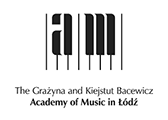Entrance examination:
- major exam (major instrument)
- and basic exams: independent preparation of a piece, sight reading, aural training
Dates of the entrance exams: 20th – 29th June 2016
Fee for the entrance exam: 130 PLN
A list of required documents for candidates for the first cycle studies is available at: http://www.amuz.lodz.pl/lifemotion/en/home-en-gb/8-system-en-gb/149761-s...
All candidates are required to apply on-line through the website www.amuz.lodz.pl
Faculty of Piano, Organ, Harpsichord and Early Instruments
• field of studies: INSTRUMENTAL STUDIES / first cycle full-time studies (3 years) majors: piano, harpsichord, organ and early instruments: Baroque violin, Baroque viola, Baroque cello, viola da gamba, traverse flute, recorder, Baroque oboe, lute.
Studies addressed to musically talented candidates, possessing certificate of secondary education, who want to continue music education and improve their skills in the field of playing a chosen instrument. Candidates must demonstrate both ability to play the instrument and general music knowledge at the level of a secondary music school.
GRADUATE PROFILE
The graduate receives a diploma of graduation of the 1st cycle studies in the scope of playing a chosen instrument and is entitled to apply for the 2nd cycle studies. The graduate possesses qualifications to work as a musician instrumentalist: soloist and chamber musician and lead didactic classes in primary music schools.
Within the frames of Instrumental studies at the Faculty of Piano, Organ, Harpsichord and Early Instruments, the Academy offers education in the following majors: piano, harpsichord, organ and early instruments: Baroque violin, Baroque viola, Baroque cello, viola da gamba, traverse flute, recorder, Baroque oboe, lute.
Pedagogical qualifications, in accordance with standards of education preparing to perform the job of a teacher, are acquired through parallel learning in Pedagogical Study.
The graduate of the 1st cycle studies possesses the following competences:
• possesses knowledge in the scope of basic repertoire related to his/her major as well as performance and artistic abilities, due to which he/she is able to transfer information and artistic ideas, understandable for specialists and people not connected to music;
• can freely and creatively use the means of artistic creation within his/her major, can use possessed knowledge in the scope of music history, literature and broadly understood cultural context to create his/her own artistic ideas, taking into consideration the newest trends in art; is able to prepare interpretation of a music piece and perform it in public; possesses abilities enabling to carry out joint artistic projects in chamber ensembles and various types of orchestras;
• possesses communication skills and ability to cooperate with other artists in order to carry out joint projects.
ENTRANCE EXAMS
• MAJOR EXAM
MAJOR INSTRUMENT
Performance of the programme at the level of secondary music school diploma.
PIANO
1. J. S. Bach – Prelude and fugue („Das wohltemperierte Klavier“).
2. A classical sonata in full (indicated sonata by L. van Beethoven – The Board may choose various parts).
3. An etude by F. Chopin from op. 10 and op. 25 (excluding E major op. 10 nr 3, E flat minor op. 10 nr 6, C sharp minor op. 25 nr 7).
4. A piece by F. Chopin
Programme must be performed from memory.
HARPSICHORD
1. J. S. Bach – Prelude and fugue or Fantasia and fugue or a piece including a fugue.
2. A pre-classical or classical sonata (e.g. W.F.Bach, C.Ph.E.Bach, J.Haydn, W.A.Mozart lub L.van Beethoven)
3. A virtuoso piece.
4. A free work.
Programme may be performed on piano or harpsichord.
ORGAN
1. A piece from the before J.S. Bach era.
2. J. S. Bach – a big form.
3. J. S. Bach – 1st or 3rd part of a chosen sonata.
4. A piece by a Romantic or 20th century composer .
BAROQUE VIOLIN
All works may be performed on contemporary or historical instrument, tuned a’415 or 440 with accompaniment of harpsichord or piano.
1. Two contrasting parts from Sonatas and Partitas by J. S. Bach (excluding fugues) or whole Fantasia for violin solo by G. Ph. Telemann.
2. A free 18th century sonata with basso continuo (whole).
BAROQUE VIOLA
All works may be performed on contemporary or historical instrument, tuned a’415 or 440 with accompaniment of harpsichord or piano.
1. Two contrasting parts from the suite by J. S. Bach for cello solo or the whole fantasia by G. Ph. Telemann for violin solo transcribed for viola solo.
2. The 18th century sonata or suite for violin and b.c. (or viola da gamba/cello) transcribed for viola and b.c.
BAROQUE CELLO
All works may be performed on contemporary or historical instrument, tuned a’415 or 440 with accompaniment of harpsichord or piano.
1. J. S. Bach – Prelude and one freely chosen part from Suita for cello solo (BWV 1007-1011).
2. A Baroque sonata for cello and basso continuo in Italian style.
3. A chosen 17thor 18th century piece (solo, with basso continuo, contrasting in style and period of time with the work from point 2).
Note: the piece from point 1 should be performed from memory; pieces from points 2 and 3 may be performed from scores.
VIOLA DA GAMBA
All works may be performed on contemporary instrument (cello or other string instrument, also guitar) or historical instrument, tuned a’415 or 440 with accompaniment of harpsichord or piano.
1. A solo 17th or 18th piece in the form of suite.
2. Two parts of Baroque sonata.
3. A 16th or 17th century piece in the form of variation or concerto.
TRAVERSO FLUTE
It is allowed to perform the programme on contemporary woodwind instrument (Western concert flute, oboe, clarinet, saxophone, bassoon).
1. An Italian or German Baroque sonata (whole).
2. A free work – solo or with accompaniment.
RECORDER
It is allowed to perform the programme on contemporary woodwind instrument (Western concert flute, oboe, clarinet, saxophone, bassoon).
1. A late Baroque Italian sonata (Handel, Telemann, Corelli, Marcello, Valentine, etc.)
2. A flute fantasia by G. Ph. Telemann (free).
BAROQUE OBOE
It is allowed to perform the programme on contemporary woodwind instrument (Western concert flute, oboe, clarinet, saxophone, bassoon).
1. A Baroque sonata – all parts.
2. A Baroque or classical concerto – parts 1 and 2.
LUTE
Programme (15-20 minutes) may be performed on a classical guitar or lute (Rennaisance lute, Baroque lute or Theorbo).
Programme for classical guitar:
1. A free work (fantasia, prelude or intabulation).
2. Two contrasting parts of sonata or suite.
3. A free work from the period of 16th – 21st centuries.
Programme for Rennaisance lute, Baroque lute or Theorbo:
1. A free work (fantasia, prelude or intabulation).
2. A dance work with duple meter (regarding Rennaisance lute and Theorbo).
3. A dance work with triple meter (regarding Baroque lute).
4. Two contrasting parts of sonata or suite (regarding Baroque lute).
5. A free work from the period of 16th – 21st centuries.
• BASIC EXAMS
INDEPENDENT PREPARATION OF A PIECE (during one hour).
SIGHT READING
AURAL TRAINING
1. A written test Filling in the missing sounds in dictations: 1-voice (atonal), 2-voice (polyphonic) and 4-voice (harmonic) and short exercises on recognition and familiarization of simple sound structures.
2. An oral test Reading notes aloud and familiarization with basic elements of music (scales, intervals, chords)

